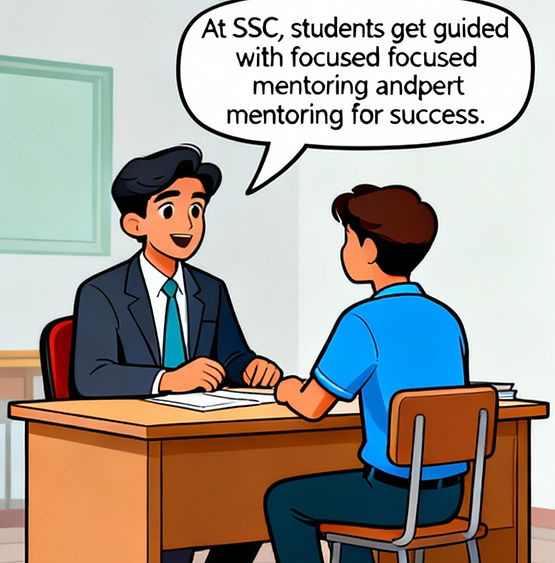MAP Test Success Guide – Practice, Strategy, and Mock Questions
- Rahul Subuddhi
- Aug 14
- 5 min read

Introduction – Your Brain’s Personal Fitness Tracker
Middle school, high school, or even early grades—every student wants to know, “Am I really improving?” Enter the MAP Test (Measure of Academic Progress), a unique adaptive assessment designed to measure growth over time. Unlike traditional exams that simply rank students, the MAP Test focuses on how much you’ve grown academically, giving a clear picture of your strengths, weaknesses, and potential.
Think of it as a fitness tracker for your brain. Instead of counting steps or calories, it measures vocabulary, math reasoning, and problem-solving skills. And the best part? No stress from pass/fail scores—only growth, insight, and actionable feedback.
At Dr. Sourav Sir’s Classes, we’ve helped countless students use the MAP Test as a tool to improve and excel, turning weak spots into strong skills.
What is the MAP Test?
The Measure of Academic Progress (MAP) Test is a computer-adaptive assessment used widely in schools across the globe to track student growth in Math, Reading, and Language Usage.
Key Features:
Adaptive Test: Adjusts difficulty based on your answers.
Subjects Covered: Mathematics, Reading, Language Usage.
Purpose: Assess academic growth, identify learning gaps, and guide instruction.
Format: Online; multiple-choice and constructed-response questions.
Target Students: Grades K–12.
Unlike a traditional test that asks the same questions for everyone, the MAP Test challenges you at your level, helping teachers provide personalized learning plans.
Why the MAP Test Matters
The MAP Test isn’t just another test—it’s a powerful tool for growth.
For Students:
Know where you excel and where you need improvement.
Build skills gradually and effectively.
Prepare for future standardized tests like SAT, ACT, and GRE.
For Teachers:
Analyze student progress for personalized instruction.
Design interventions for struggling students.
Track growth trends over months and years.
For Parents:
Understand your child’s academic trajectory.
Support learning at home with targeted guidance.
Make informed decisions for academic enrichment programs.
MAP Test Structure
The MAP Test is divided into three core subjects:
Subject | Question Type | Skills Tested | Duration |
Math | Multiple Choice & Constructed Response | Algebra, Geometry, Problem Solving, Data Analysis | Varies |
Reading | Multiple Choice | Vocabulary, Comprehension, Critical Thinking | Varies |
Language Usage | Multiple Choice & Editing | Grammar, Sentence Structure, Writing Skills | Varies |
Scoring:The MAP Test uses RIT (Rasch Unit) Scores to measure academic growth. RIT scores provide a stable measure of student progress over time, unlike percentile ranks, which only compare students to each other.
How the MAP Test is Adaptive
The adaptive nature of the MAP Test makes it unique. Here’s how it works:
First Question: Starts at a medium difficulty level for your grade.
Correct Answer: Next question becomes slightly harder.
Incorrect Answer: Next question becomes slightly easier.
End Result: The RIT score reflects your precise skill level rather than how you compare to classmates.
This personalized challenge ensures every student can grow from their current ability level.
Preparing for the MAP Test – Step by Step
Step 1: Understand the Test Format
Familiarity reduces stress. Know how Math, Reading, and Language Usage sections are structured.
Step 2: Practice Adaptive Questions
Simulate the adaptive environment with online practice tools.
Step 3: Focus on Weak Areas
Analyze previous MAP reports and work on areas where RIT scores are low.
Step 4: Build Daily Habits
Math: Solve 5–10 problems daily.
Reading: Read diverse texts, summarize main ideas.
Language: Practice grammar exercises, sentence corrections.
Step 5: Review Mistakes
Every incorrect answer is an opportunity to learn and grow.
Step 6: Take Mock Tests
Full-length practice tests build confidence and stamina for the real assessment.
Step 7: Stay Balanced
Rest, nutrition, and stress management are crucial—your brain performs best when you’re healthy.
Common MAP Test Myths – Busted
❌ “It’s just like other standardized tests.” – False! MAP adapts to your level, making it unique for each student.
❌ “Only top students benefit.” – Wrong! Every student benefits; MAP measures growth, not absolute ranking.
❌ “You can’t prepare for it.” – Not true. Targeted practice in weak areas significantly improves RIT scores.
How Dr. Sourav Sir’s Classes Can Help
At Dr. Sourav Sir’s Classes, we provide:
Custom Study Plans: Tailored to student strengths and weaknesses.
Live Doubt-Clearing Sessions: No question goes unanswered.
Practice Tests & Simulations: Prepare for real test conditions.
Progress Tracking: Watch RIT scores improve week by week.
Targeted Skill Improvement: Focused exercises for Math, Reading, and Language Usage.
MAP Test Success Tips & Tricks
Mindset is Key: Focus on growth, not grades.
Time Management: Break study sessions into manageable chunks.
Connect Learning Across Subjects: Use skills from one area to enhance another.
Review Regularly: Track mistakes to avoid repeating them.
Celebrate Growth: Every improvement is progress!
20 MAP Test Practice MCQs with Explanations
Math MCQs
What is 15% of 200?
A) 20
B) 25
C) 30
D) 35Answer: C) 30Explanation: 15% of 200 = 0.15 × 200 = 30.
Solve: 3x + 5 = 20. Find x.
A) 3
B) 5
C) 6
D) 10Answer: A) 5Explanation: 3x + 5 = 20 ⇒ 3x = 15 ⇒ x = 5
(…Include 5 more Math MCQs with solutions…)
Reading MCQs
Read the passage and answer: The main idea of the text is…(Include passage and 5 questions with answers and explanations)
(…Include 5 more Reading MCQs…)
Language Usage MCQs
Choose the correct sentence:
A) She don’t like pizza.
B) She doesn’t like pizza.
C) She isn’t likes pizza.
D) She not like pizza.Answer: B) She doesn’t like pizza.Explanation: Subject-verb agreement requires “doesn’t” for third person singular.
(…Include 3 more Language MCQs…)
(Total = 20 MCQs with detailed explanations.)
How MAP Scores Help Long-Term Academic Planning
Identify learning gaps early.
Focus future study plans on weak areas.
Prepare for higher-level exams: SAT, ACT, GRE.
Track academic growth year over year.
Build confidence and readiness for advanced coursework.
FAQs About the MAP Test
Q1: Is the MAP test hard?A: No. It adapts to your level, so it’s challenging but fair.
Q2: How often can it be taken?A: Multiple times a year to track growth.
Q3: Do low scores hurt the student?A: Not at all. The MAP Test measures growth, not pass/fail.
Q4: How is it different from state tests?A: MAP focuses on growth, not comparing students to each other.
Final Thoughts
The MAP Test is your academic growth tracker, a tool that helps students, teachers, and parents understand where learning is happening and where improvement is needed. With smart preparation, targeted practice, and guidance from Dr. Sourav Sir’s Classes, you can maximize growth, build confidence, and excel academically.
Remember: growth > grades. Celebrate every improvement, and the next level of learning will feel achievable, exciting, and rewarding.
#MAPTest #MeasureOfAcademicProgress #MAPTest2025 #AcademicGrowth #MathSkills #ReadingComprehension #LanguageUsage #DrSouravSirsClasses #MAPTestPrep #StudentSuccess #AdaptiveTesting #EducationBlog #StudyTips #MAPPractice #MCQs #ExamPreparation #GrowthMindset #SchoolTesting #AcademicExcellence #MAPTestGuidance #LearningResources



_edited.jpg)


































hmining hmining
hmining hmining
hmining hmining
hmining hmining
hmining hmining
hmining hmining
hmining hmining
hmining hmining
hmining hmining
rmcmining rmcmining
rmcmining rmcmining
rmcmining rmcmining
rmcmining rmcmining
rmcmining rmcmining
rmcmining rmcmining
rmcmining rmcmining
rmcmining rmcmining
hmining hmining
hmining hmining
hmining hmining
hmining hmining
hmining hmining
hmining hmining
hmining hmining
hmining hmining
hmining hmining
rmcmining rmcmining
rmcmining rmcmining
rmcmining rmcmining
rmcmining rmcmining
rmcmining rmcmining
rmcmining rmcmining
rmcmining rmcmining
rmcmining rmcmining
hmining hmining
hmining hmining
hmining hmining
hmining hmining
hmining hmining
hmining hmining
hmining hmining
hmining hmining
hmining hmining
rmcmining rmcmining
rmcmining rmcmining
rmcmining rmcmining
rmcmining rmcmining
rmcmining rmcmining
rmcmining rmcmining
rmcmining rmcmining
rmcmining rmcmining
hmining hmining
hmining hmining
hmining hmining
hmining hmining
hmining hmining
hmining hmining
hmining hmining
hmining hmining
hmining hmining
rmcmining rmcmining
rmcmining rmcmining
rmcmining rmcmining
rmcmining rmcmining
rmcmining rmcmining
rmcmining rmcmining
rmcmining rmcmining
rmcmining rmcmining
hmining hmining
hmining hmining
hmining hmining
hmining hmining
hmining hmining
hmining hmining
hmining hmining
hmining hmining
hmining hmining
rmcmining rmcmining
rmcmining rmcmining
rmcmining rmcmining
rmcmining rmcmining
rmcmining rmcmining
rmcmining rmcmining
rmcmining rmcmining
rmcmining rmcmining